Project Management: Activity and Risk Planning for Project Success
VerifiedAdded on 2021/08/23
|5
|1875
|63
Report
AI Summary
This report delves into the critical aspects of project management, specifically focusing on activity and risk planning. It emphasizes the importance of aligning project objectives with the overall organizational mission and strategy, highlighting the significance of senior management involvement in the initial project launch meeting. The report outlines the essential elements of a project plan, including scope definition, risk management, resource allocation, and schedule development. It also covers the use of work breakdown structures (WBS) and linear responsibility charts for organizing tasks and assigning responsibilities. Furthermore, the report discusses the role of system integration and interface coordination in complex projects, emphasizing the need for effective communication and conflict resolution within multidisciplinary teams. The report concludes by presenting a planning model designed to overcome conflicts in multidisciplinary teams, promoting a cohesive approach to project execution.
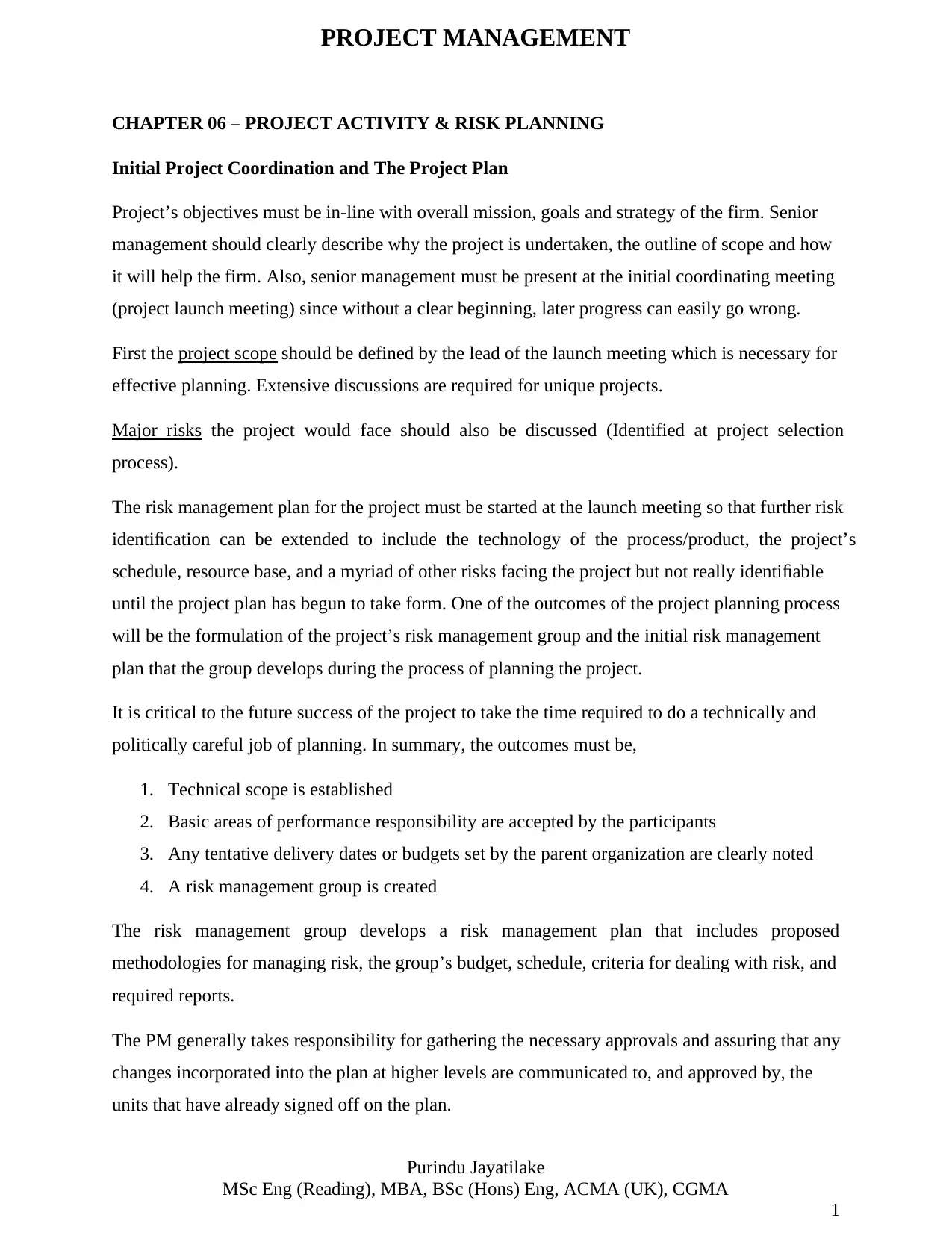
PROJECT MANAGEMENT
Purindu Jayatilake
MSc Eng (Reading), MBA, BSc (Hons) Eng, ACMA (UK), CGMA
1
CHAPTER 06 – PROJECT ACTIVITY & RISK PLANNING
Initial Project Coordination and The Project Plan
Project’s objectives must be in-line with overall mission, goals and strategy of the firm. Senior
management should clearly describe why the project is undertaken, the outline of scope and how
it will help the firm. Also, senior management must be present at the initial coordinating meeting
(project launch meeting) since without a clear beginning, later progress can easily go wrong.
First the project scope should be defined by the lead of the launch meeting which is necessary for
effective planning. Extensive discussions are required for unique projects.
Major risks the project would face should also be discussed (Identified at project selection
process).
The risk management plan for the project must be started at the launch meeting so that further risk
identification can be extended to include the technology of the process/product, the project’s
schedule, resource base, and a myriad of other risks facing the project but not really identifiable
until the project plan has begun to take form. One of the outcomes of the project planning process
will be the formulation of the project’s risk management group and the initial risk management
plan that the group develops during the process of planning the project.
It is critical to the future success of the project to take the time required to do a technically and
politically careful job of planning. In summary, the outcomes must be,
1. Technical scope is established
2. Basic areas of performance responsibility are accepted by the participants
3. Any tentative delivery dates or budgets set by the parent organization are clearly noted
4. A risk management group is created
The risk management group develops a risk management plan that includes proposed
methodologies for managing risk, the group’s budget, schedule, criteria for dealing with risk, and
required reports.
The PM generally takes responsibility for gathering the necessary approvals and assuring that any
changes incorporated into the plan at higher levels are communicated to, and approved by, the
units that have already signed off on the plan.
Purindu Jayatilake
MSc Eng (Reading), MBA, BSc (Hons) Eng, ACMA (UK), CGMA
1
CHAPTER 06 – PROJECT ACTIVITY & RISK PLANNING
Initial Project Coordination and The Project Plan
Project’s objectives must be in-line with overall mission, goals and strategy of the firm. Senior
management should clearly describe why the project is undertaken, the outline of scope and how
it will help the firm. Also, senior management must be present at the initial coordinating meeting
(project launch meeting) since without a clear beginning, later progress can easily go wrong.
First the project scope should be defined by the lead of the launch meeting which is necessary for
effective planning. Extensive discussions are required for unique projects.
Major risks the project would face should also be discussed (Identified at project selection
process).
The risk management plan for the project must be started at the launch meeting so that further risk
identification can be extended to include the technology of the process/product, the project’s
schedule, resource base, and a myriad of other risks facing the project but not really identifiable
until the project plan has begun to take form. One of the outcomes of the project planning process
will be the formulation of the project’s risk management group and the initial risk management
plan that the group develops during the process of planning the project.
It is critical to the future success of the project to take the time required to do a technically and
politically careful job of planning. In summary, the outcomes must be,
1. Technical scope is established
2. Basic areas of performance responsibility are accepted by the participants
3. Any tentative delivery dates or budgets set by the parent organization are clearly noted
4. A risk management group is created
The risk management group develops a risk management plan that includes proposed
methodologies for managing risk, the group’s budget, schedule, criteria for dealing with risk, and
required reports.
The PM generally takes responsibility for gathering the necessary approvals and assuring that any
changes incorporated into the plan at higher levels are communicated to, and approved by, the
units that have already signed off on the plan.
Paraphrase This Document
Need a fresh take? Get an instant paraphrase of this document with our AI Paraphraser
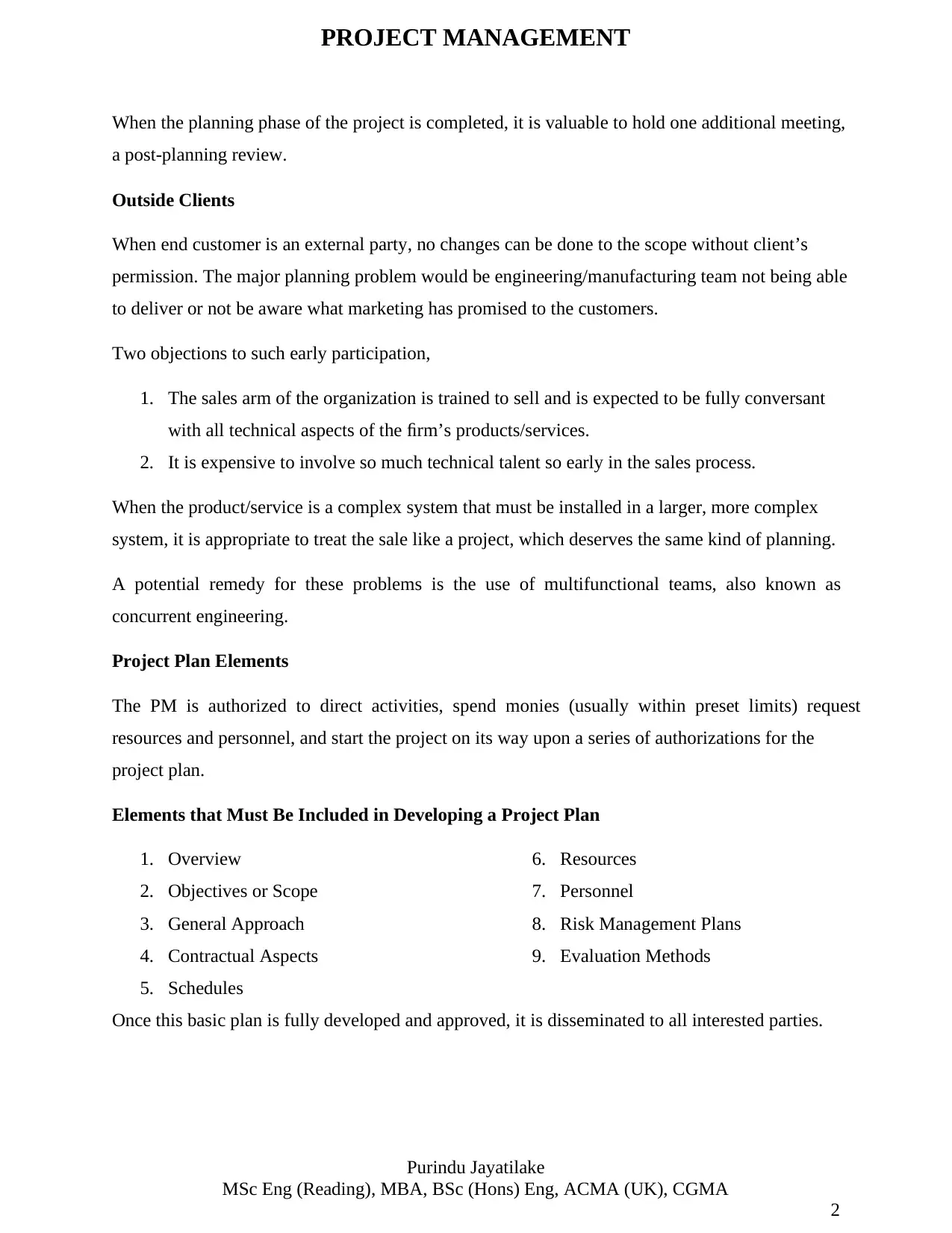
PROJECT MANAGEMENT
Purindu Jayatilake
MSc Eng (Reading), MBA, BSc (Hons) Eng, ACMA (UK), CGMA
2
When the planning phase of the project is completed, it is valuable to hold one additional meeting,
a post-planning review.
Outside Clients
When end customer is an external party, no changes can be done to the scope without client’s
permission. The major planning problem would be engineering/manufacturing team not being able
to deliver or not be aware what marketing has promised to the customers.
Two objections to such early participation,
1. The sales arm of the organization is trained to sell and is expected to be fully conversant
with all technical aspects of the firm’s products/services.
2. It is expensive to involve so much technical talent so early in the sales process.
When the product/service is a complex system that must be installed in a larger, more complex
system, it is appropriate to treat the sale like a project, which deserves the same kind of planning.
A potential remedy for these problems is the use of multifunctional teams, also known as
concurrent engineering.
Project Plan Elements
The PM is authorized to direct activities, spend monies (usually within preset limits) request
resources and personnel, and start the project on its way upon a series of authorizations for the
project plan.
Elements that Must Be Included in Developing a Project Plan
1. Overview
2. Objectives or Scope
3. General Approach
4. Contractual Aspects
5. Schedules
6. Resources
7. Personnel
8. Risk Management Plans
9. Evaluation Methods
Once this basic plan is fully developed and approved, it is disseminated to all interested parties.
Purindu Jayatilake
MSc Eng (Reading), MBA, BSc (Hons) Eng, ACMA (UK), CGMA
2
When the planning phase of the project is completed, it is valuable to hold one additional meeting,
a post-planning review.
Outside Clients
When end customer is an external party, no changes can be done to the scope without client’s
permission. The major planning problem would be engineering/manufacturing team not being able
to deliver or not be aware what marketing has promised to the customers.
Two objections to such early participation,
1. The sales arm of the organization is trained to sell and is expected to be fully conversant
with all technical aspects of the firm’s products/services.
2. It is expensive to involve so much technical talent so early in the sales process.
When the product/service is a complex system that must be installed in a larger, more complex
system, it is appropriate to treat the sale like a project, which deserves the same kind of planning.
A potential remedy for these problems is the use of multifunctional teams, also known as
concurrent engineering.
Project Plan Elements
The PM is authorized to direct activities, spend monies (usually within preset limits) request
resources and personnel, and start the project on its way upon a series of authorizations for the
project plan.
Elements that Must Be Included in Developing a Project Plan
1. Overview
2. Objectives or Scope
3. General Approach
4. Contractual Aspects
5. Schedules
6. Resources
7. Personnel
8. Risk Management Plans
9. Evaluation Methods
Once this basic plan is fully developed and approved, it is disseminated to all interested parties.
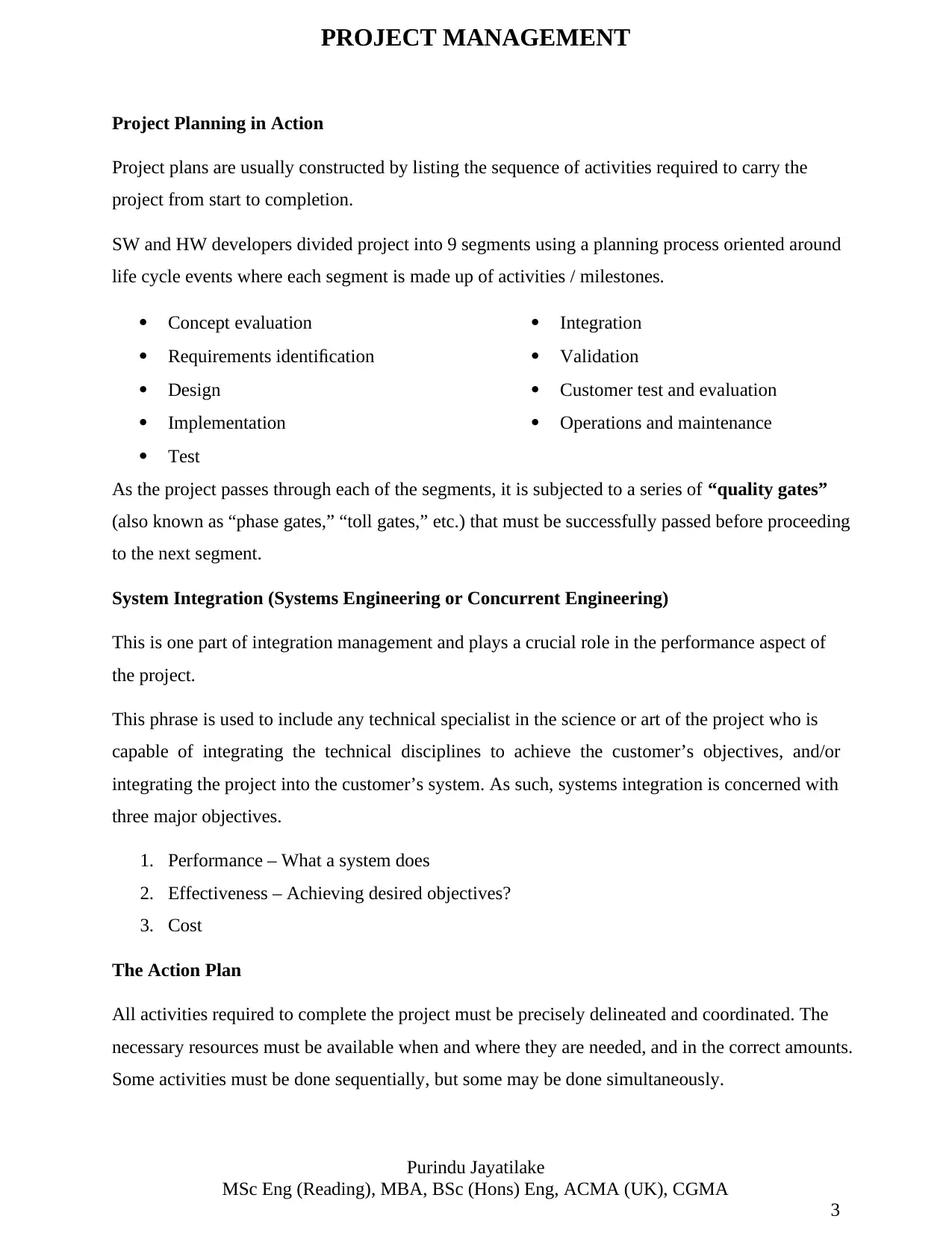
PROJECT MANAGEMENT
Purindu Jayatilake
MSc Eng (Reading), MBA, BSc (Hons) Eng, ACMA (UK), CGMA
3
Project Planning in Action
Project plans are usually constructed by listing the sequence of activities required to carry the
project from start to completion.
SW and HW developers divided project into 9 segments using a planning process oriented around
life cycle events where each segment is made up of activities / milestones.
Concept evaluation
Requirements identification
Design
Implementation
Test
Integration
Validation
Customer test and evaluation
Operations and maintenance
As the project passes through each of the segments, it is subjected to a series of “quality gates”
(also known as “phase gates,” “toll gates,” etc.) that must be successfully passed before proceeding
to the next segment.
System Integration (Systems Engineering or Concurrent Engineering)
This is one part of integration management and plays a crucial role in the performance aspect of
the project.
This phrase is used to include any technical specialist in the science or art of the project who is
capable of integrating the technical disciplines to achieve the customer’s objectives, and/or
integrating the project into the customer’s system. As such, systems integration is concerned with
three major objectives.
1. Performance – What a system does
2. Effectiveness – Achieving desired objectives?
3. Cost
The Action Plan
All activities required to complete the project must be precisely delineated and coordinated. The
necessary resources must be available when and where they are needed, and in the correct amounts.
Some activities must be done sequentially, but some may be done simultaneously.
Purindu Jayatilake
MSc Eng (Reading), MBA, BSc (Hons) Eng, ACMA (UK), CGMA
3
Project Planning in Action
Project plans are usually constructed by listing the sequence of activities required to carry the
project from start to completion.
SW and HW developers divided project into 9 segments using a planning process oriented around
life cycle events where each segment is made up of activities / milestones.
Concept evaluation
Requirements identification
Design
Implementation
Test
Integration
Validation
Customer test and evaluation
Operations and maintenance
As the project passes through each of the segments, it is subjected to a series of “quality gates”
(also known as “phase gates,” “toll gates,” etc.) that must be successfully passed before proceeding
to the next segment.
System Integration (Systems Engineering or Concurrent Engineering)
This is one part of integration management and plays a crucial role in the performance aspect of
the project.
This phrase is used to include any technical specialist in the science or art of the project who is
capable of integrating the technical disciplines to achieve the customer’s objectives, and/or
integrating the project into the customer’s system. As such, systems integration is concerned with
three major objectives.
1. Performance – What a system does
2. Effectiveness – Achieving desired objectives?
3. Cost
The Action Plan
All activities required to complete the project must be precisely delineated and coordinated. The
necessary resources must be available when and where they are needed, and in the correct amounts.
Some activities must be done sequentially, but some may be done simultaneously.
⊘ This is a preview!⊘
Do you want full access?
Subscribe today to unlock all pages.

Trusted by 1+ million students worldwide
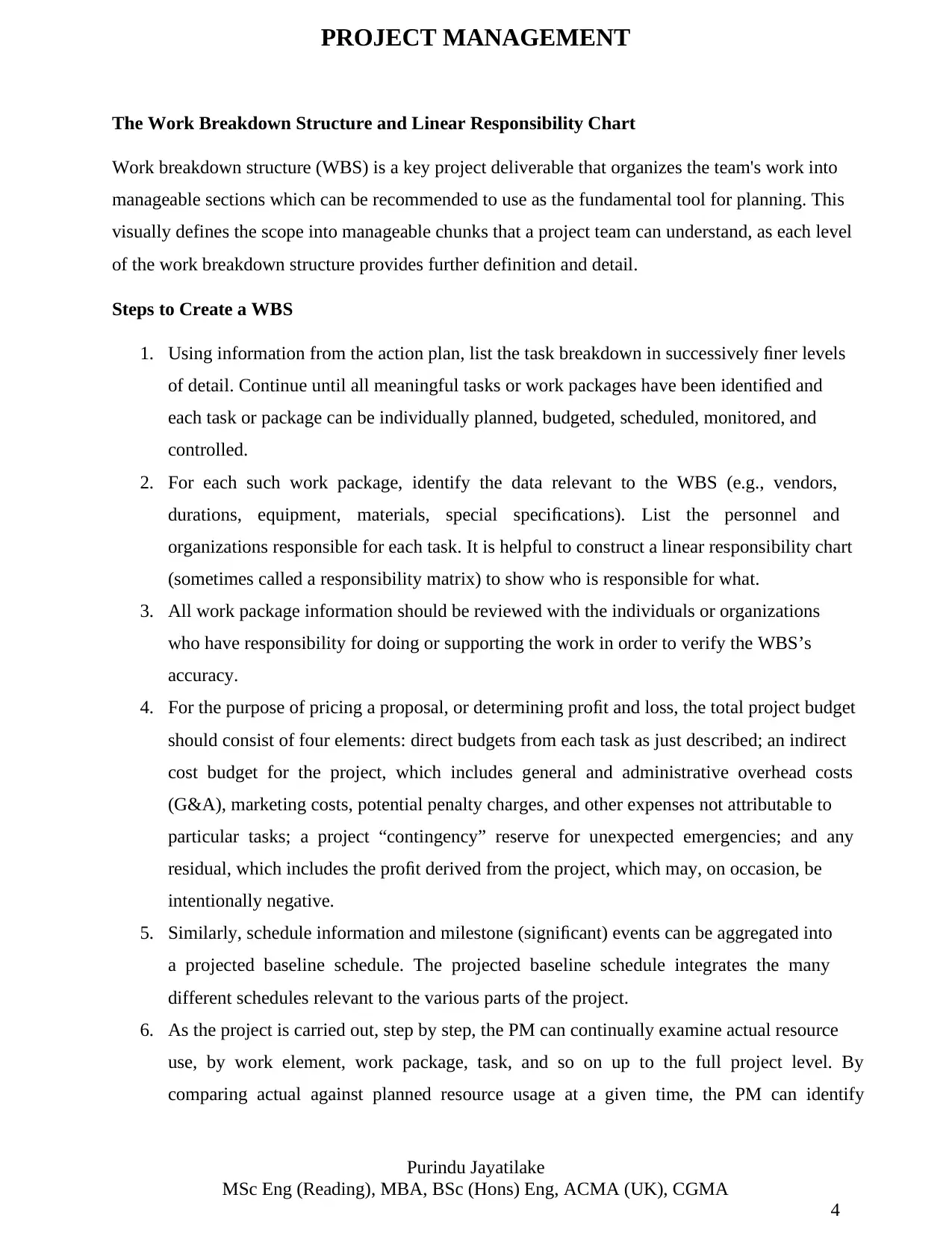
PROJECT MANAGEMENT
Purindu Jayatilake
MSc Eng (Reading), MBA, BSc (Hons) Eng, ACMA (UK), CGMA
4
The Work Breakdown Structure and Linear Responsibility Chart
Work breakdown structure (WBS) is a key project deliverable that organizes the team's work into
manageable sections which can be recommended to use as the fundamental tool for planning. This
visually defines the scope into manageable chunks that a project team can understand, as each level
of the work breakdown structure provides further definition and detail.
Steps to Create a WBS
1. Using information from the action plan, list the task breakdown in successively finer levels
of detail. Continue until all meaningful tasks or work packages have been identified and
each task or package can be individually planned, budgeted, scheduled, monitored, and
controlled.
2. For each such work package, identify the data relevant to the WBS (e.g., vendors,
durations, equipment, materials, special specifications). List the personnel and
organizations responsible for each task. It is helpful to construct a linear responsibility chart
(sometimes called a responsibility matrix) to show who is responsible for what.
3. All work package information should be reviewed with the individuals or organizations
who have responsibility for doing or supporting the work in order to verify the WBS’s
accuracy.
4. For the purpose of pricing a proposal, or determining profit and loss, the total project budget
should consist of four elements: direct budgets from each task as just described; an indirect
cost budget for the project, which includes general and administrative overhead costs
(G&A), marketing costs, potential penalty charges, and other expenses not attributable to
particular tasks; a project “contingency” reserve for unexpected emergencies; and any
residual, which includes the profit derived from the project, which may, on occasion, be
intentionally negative.
5. Similarly, schedule information and milestone (significant) events can be aggregated into
a projected baseline schedule. The projected baseline schedule integrates the many
different schedules relevant to the various parts of the project.
6. As the project is carried out, step by step, the PM can continually examine actual resource
use, by work element, work package, task, and so on up to the full project level. By
comparing actual against planned resource usage at a given time, the PM can identify
Purindu Jayatilake
MSc Eng (Reading), MBA, BSc (Hons) Eng, ACMA (UK), CGMA
4
The Work Breakdown Structure and Linear Responsibility Chart
Work breakdown structure (WBS) is a key project deliverable that organizes the team's work into
manageable sections which can be recommended to use as the fundamental tool for planning. This
visually defines the scope into manageable chunks that a project team can understand, as each level
of the work breakdown structure provides further definition and detail.
Steps to Create a WBS
1. Using information from the action plan, list the task breakdown in successively finer levels
of detail. Continue until all meaningful tasks or work packages have been identified and
each task or package can be individually planned, budgeted, scheduled, monitored, and
controlled.
2. For each such work package, identify the data relevant to the WBS (e.g., vendors,
durations, equipment, materials, special specifications). List the personnel and
organizations responsible for each task. It is helpful to construct a linear responsibility chart
(sometimes called a responsibility matrix) to show who is responsible for what.
3. All work package information should be reviewed with the individuals or organizations
who have responsibility for doing or supporting the work in order to verify the WBS’s
accuracy.
4. For the purpose of pricing a proposal, or determining profit and loss, the total project budget
should consist of four elements: direct budgets from each task as just described; an indirect
cost budget for the project, which includes general and administrative overhead costs
(G&A), marketing costs, potential penalty charges, and other expenses not attributable to
particular tasks; a project “contingency” reserve for unexpected emergencies; and any
residual, which includes the profit derived from the project, which may, on occasion, be
intentionally negative.
5. Similarly, schedule information and milestone (significant) events can be aggregated into
a projected baseline schedule. The projected baseline schedule integrates the many
different schedules relevant to the various parts of the project.
6. As the project is carried out, step by step, the PM can continually examine actual resource
use, by work element, work package, task, and so on up to the full project level. By
comparing actual against planned resource usage at a given time, the PM can identify
Paraphrase This Document
Need a fresh take? Get an instant paraphrase of this document with our AI Paraphraser
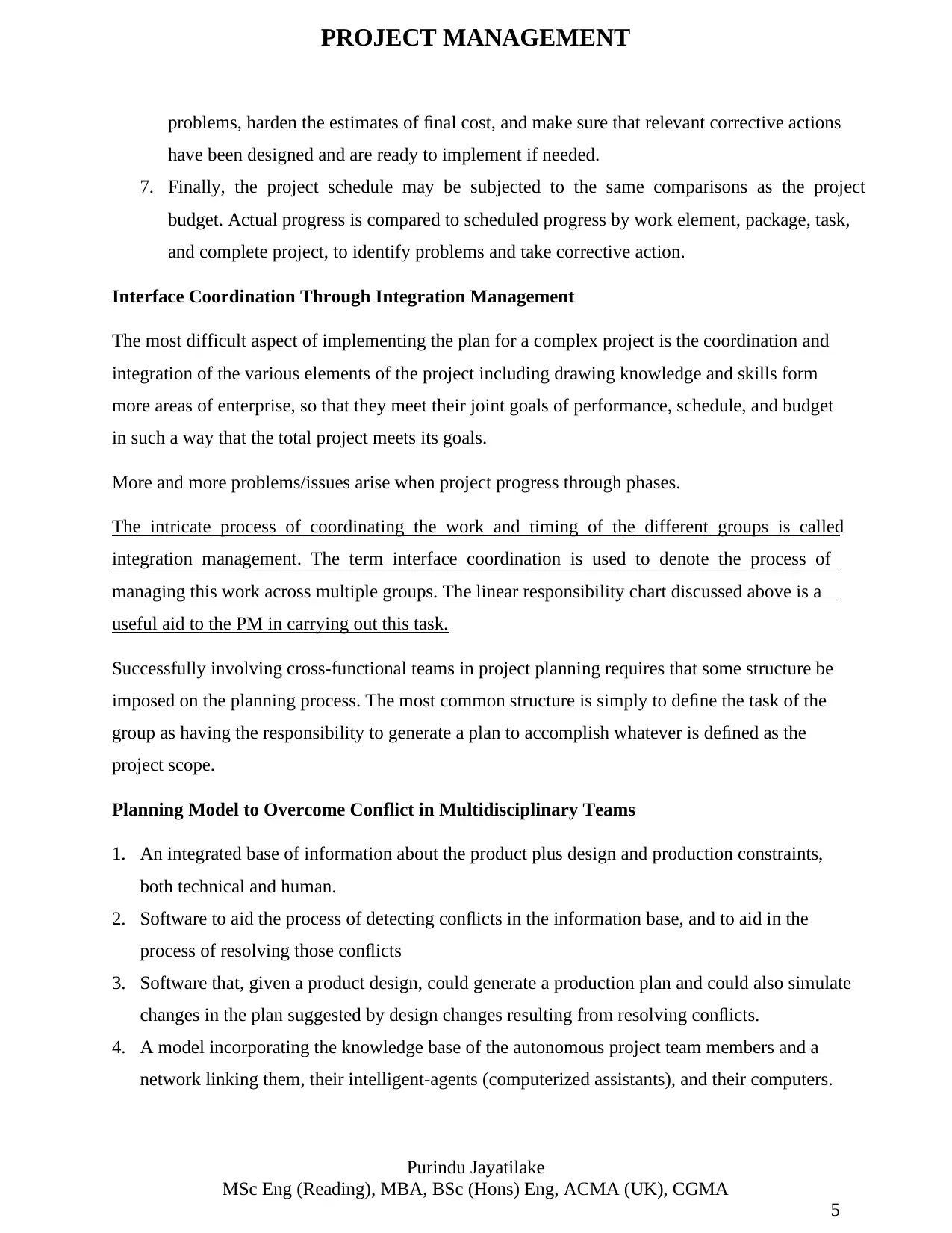
PROJECT MANAGEMENT
Purindu Jayatilake
MSc Eng (Reading), MBA, BSc (Hons) Eng, ACMA (UK), CGMA
5
problems, harden the estimates of final cost, and make sure that relevant corrective actions
have been designed and are ready to implement if needed.
7. Finally, the project schedule may be subjected to the same comparisons as the project
budget. Actual progress is compared to scheduled progress by work element, package, task,
and complete project, to identify problems and take corrective action.
Interface Coordination Through Integration Management
The most difficult aspect of implementing the plan for a complex project is the coordination and
integration of the various elements of the project including drawing knowledge and skills form
more areas of enterprise, so that they meet their joint goals of performance, schedule, and budget
in such a way that the total project meets its goals.
More and more problems/issues arise when project progress through phases.
The intricate process of coordinating the work and timing of the different groups is called
integration management. The term interface coordination is used to denote the process of
managing this work across multiple groups. The linear responsibility chart discussed above is a
useful aid to the PM in carrying out this task.
Successfully involving cross-functional teams in project planning requires that some structure be
imposed on the planning process. The most common structure is simply to define the task of the
group as having the responsibility to generate a plan to accomplish whatever is defined as the
project scope.
Planning Model to Overcome Conflict in Multidisciplinary Teams
1. An integrated base of information about the product plus design and production constraints,
both technical and human.
2. Software to aid the process of detecting conflicts in the information base, and to aid in the
process of resolving those conflicts
3. Software that, given a product design, could generate a production plan and could also simulate
changes in the plan suggested by design changes resulting from resolving conflicts.
4. A model incorporating the knowledge base of the autonomous project team members and a
network linking them, their intelligent-agents (computerized assistants), and their computers.
Purindu Jayatilake
MSc Eng (Reading), MBA, BSc (Hons) Eng, ACMA (UK), CGMA
5
problems, harden the estimates of final cost, and make sure that relevant corrective actions
have been designed and are ready to implement if needed.
7. Finally, the project schedule may be subjected to the same comparisons as the project
budget. Actual progress is compared to scheduled progress by work element, package, task,
and complete project, to identify problems and take corrective action.
Interface Coordination Through Integration Management
The most difficult aspect of implementing the plan for a complex project is the coordination and
integration of the various elements of the project including drawing knowledge and skills form
more areas of enterprise, so that they meet their joint goals of performance, schedule, and budget
in such a way that the total project meets its goals.
More and more problems/issues arise when project progress through phases.
The intricate process of coordinating the work and timing of the different groups is called
integration management. The term interface coordination is used to denote the process of
managing this work across multiple groups. The linear responsibility chart discussed above is a
useful aid to the PM in carrying out this task.
Successfully involving cross-functional teams in project planning requires that some structure be
imposed on the planning process. The most common structure is simply to define the task of the
group as having the responsibility to generate a plan to accomplish whatever is defined as the
project scope.
Planning Model to Overcome Conflict in Multidisciplinary Teams
1. An integrated base of information about the product plus design and production constraints,
both technical and human.
2. Software to aid the process of detecting conflicts in the information base, and to aid in the
process of resolving those conflicts
3. Software that, given a product design, could generate a production plan and could also simulate
changes in the plan suggested by design changes resulting from resolving conflicts.
4. A model incorporating the knowledge base of the autonomous project team members and a
network linking them, their intelligent-agents (computerized assistants), and their computers.
1 out of 5
Related Documents
Your All-in-One AI-Powered Toolkit for Academic Success.
+13062052269
info@desklib.com
Available 24*7 on WhatsApp / Email
![[object Object]](/_next/static/media/star-bottom.7253800d.svg)
Unlock your academic potential
Copyright © 2020–2025 A2Z Services. All Rights Reserved. Developed and managed by ZUCOL.





